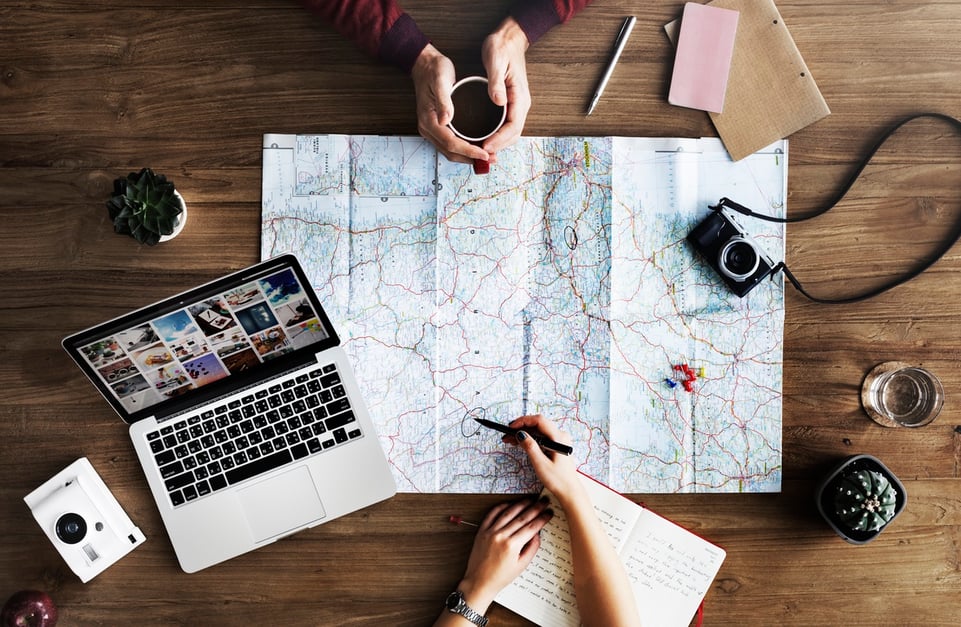Four more places you can find design inspiration.
Feel stuck, lacking inspiration and ideas for a design project on your plate? In Part 1 of this series, we shared 3 places where you can find design inspiration. If you’re looking for even more, here’s 4 more ways to combat the dreaded creative block.
- Pinterest
We love to collect ideas on Pinterest. You can use it to create virtual mood boards when you’re not sure where to start. It can serve as your hub to pin links to your favorite sites, or you can go on Pinterest directly and search for inspiration there. Just type in what you’re looking for! Plus, it’s helpful to see what’s out there already when you’re designing a logo, for instance, so you can avoid copying someone else’s work.
- Mood boards
We just talked about using Pinterest to create virtual mood boards. You can also pull items into Adobe Illustrator and create mood boards directly in there. Another way to do this is to create a physical mood board using a bulletin board, for instance. It’s fun to pull together textures, fabrics, colors, swatches, photos and other ideas for implementation because it gives the materials a voice or a personality visually. We created a mood board at Fishhook when we redesigned our website. It helped us to pull together our ideas and the vibe we were going for, and it put us on a clear path for design and implementation.
Sometimes we also use mood boards when developing new brands. It can be helpful to show a mood board to a client when we need more direction from them upfront before we start designing (instead of vice versa). It helps establish some creative, artistic direction if you don’t have it yet, and it’s helpful for the client too if they’re not totally sure what they want. It’s also a nice way to set boundaries and eliminate what won’t work for the project at hand.
- Collaborate with other experts or friends
Marie (my fellow Fishhook designer) and I bounce ideas off each other all the time. It’s great to get a second set of eyes on your work and have some fresh, outside perspective because you’re so “in it” as the designer on the project. We also appreciate having another designer take a look because they’re someone who knows the language of design, can suggest other techniques to try and can give constructive feedback. It’s helpful to get other Fishhookers’ perspectives too, even if it’s simply to help with wording or check for grammar, to make sure the design is on par with what the client asked for.
Someone else you can collaborate with is your local printer. When we’ve taken field trips to tour the facilities of local printers, those visits have helped us better understand what their capabilities are and generally what is possible in print. We’ve learned about techniques we hadn’t been aware of and new technologies that make projects less expensive and easier to produce. One fun example: There are specialty papers that are embedded with plant seeds and can actually be buried in the ground to grow wildflowers or herbs! Pretty cool, huh?
Another way to collaborate is at Creative Mornings, a monthly breakfast lecture series for the local creative community (writers, designers and creative types of any kind). Free gatherings are held nationwide, and a local speaker/presenter shares on that month’s topic or theme. It’s a great way to network, share ideas and meet people who are doing similar work in your local area.
- Go somewhere new
Change up your scenery and go somewhere you don’t normally frequent. This could mean taking a walk, visiting an art museum, going to the mall or sitting at a coffee shop. These kinds of field trips are great for generating ideas for what will work or won’t work because you can see real-life design work in action. For example, take a trip to the mall and critique the logos you see. Pay attention to the surroundings (window displays, signage, etc.) to see how they affect a particular brand. You can also get inspiration for color palettes in all sorts of places, including through advertising, the physical spaces you see and people-watching.
We hope this series inspires you to try something new when faced with a creative block. We’d love to hear the ideas you try and the results you experience!
